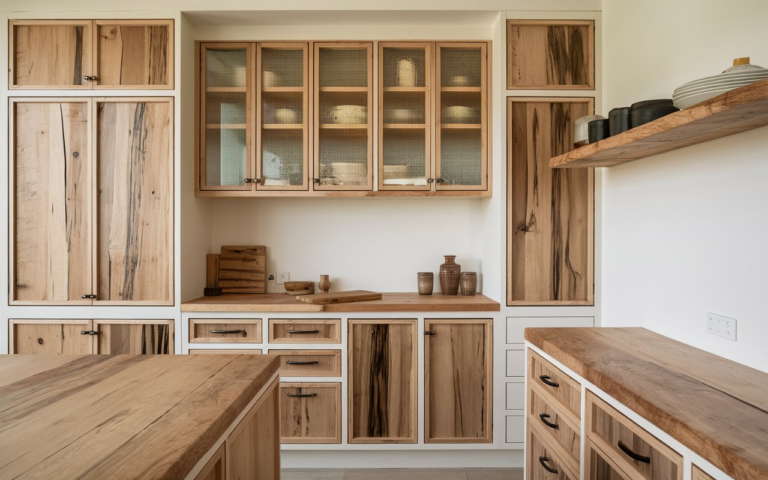25 Wabi Sabi Living Room Ideas: Embrace Imperfection with Timeless Charm

When it comes to interior design, many people chase after perfection—polished floors, symmetrical arrangements, flawless lines.
But there’s a philosophy that stands in contrast to this pursuit of flawlessness: Wabi Sabi. This Japanese aesthetic celebrates the beauty of imperfection, transience, and authenticity.
It’s about finding the extraordinary in the ordinary, the calm in the chaos, and seeing the beauty in the things that time has touched.
If you’ve ever walked into a room and felt like it had a soul, like it wasn’t just a space, but a story waiting to be told—then you’ve probably encountered Wabi Sabi. It’s about embracing nature, aging gracefully, and creating a space that feels deeply personal.
Now, you might be wondering: How does Wabi Sabi translate into a living room setting? Well, let’s explore 25 Wabi Sabi living room ideas that will help you infuse this timeless philosophy into your home, creating a space that is both tranquil and uniquely your own.
1. Neutral Tones for Tranquil Vibes

The foundation of any Wabi Sabi space starts with neutral tones. Think earthy beiges, soft greys, muted greens, and off-whites. These colors create a serene and calming atmosphere, perfect for relaxing after a long day.
Pro Tip: Pair natural wood tones with soft neutral walls to create a soothing and balanced environment.
2. Embrace Natural Materials
Wabi Sabi is deeply connected to nature. So, when designing your living room, opt for natural materials like wood, stone, cotton, and linen. These materials celebrate the raw beauty of the world around us.
Personal Anecdote: When I designed my living room with Wabi Sabi in mind, I chose a reclaimed wooden coffee table. Its weathered texture and imperfections added character and warmth, making the space feel like it had lived through years of stories.
3. Handmade and Artisan Pieces

Incorporating handmade or artisanal furniture and decor pieces adds authenticity to your space. Wabi Sabi appreciates craftsmanship and the unique imperfections that come with handmade items. Look for one-of-a-kind items that reflect the soul of their creator.
Styling Tip: Look for handwoven rugs or pottery with visible marks or textures. These small imperfections create a sense of history and intimacy.
4. Embrace the Beauty of Aging
One of the core tenets of Wabi Sabi is accepting the passage of time. This means celebrating pieces that show signs of wear and age. Whether it’s a vintage armchair or a weathered shelf, the signs of time create a lived-in feel that is warm and inviting.
Tip: Don’t shy away from furniture or decor that has scratches, stains, or faded colors. These imperfections tell the story of a piece’s journey.
5. Minimalist Approach with a Personal Touch
Wabi Sabi aligns well with minimalism—but with a twist. It’s not about stripping a room down to bare essentials; it’s about being intentional with the items you choose. Keep only what brings you joy or has purpose, and let the space breathe.
Example: A single potted plant or a simple sofa in a muted color can be the focal point of the room, while the rest of the space remains open and uncluttered.
6. Vintage and Antique Finds
Incorporating vintage or antique furniture pieces is a perfect way to embrace Wabi Sabi. The charm of worn wood, faded upholstery, or a dented metal lamp fits seamlessly into this philosophy.
Pro Tip: Check out secondhand stores or flea markets for pieces with character. The beauty of these items often lies in their age and history.
7. Textural Contrast

A key feature of Wabi Sabi is textural contrast. Mix rough and smooth surfaces to create visual interest and balance. For example, pair a coarse wool throw with a sleek, polished stone coffee table.
Styling Tip: A mix of textured cushions, linen drapes, and soft, woven rugs can create layers of interest and warmth in your living room.
8. Organic Shapes Over Perfect Lines

Wabi Sabi celebrates organic shapes rather than geometric precision. Look for furniture and decor with curved edges or pieces that don’t conform to rigid shapes. A round coffee table, a soft chair, or flowing curtains add an element of softness and flow.
9. Open Shelving with Displayed Treasures
Instead of hiding everything away in cabinets or drawers, embrace open shelving and display objects that have meaning. Whether it’s a collection of books, ceramics, or souvenirs from your travels, let your treasures be visible.
Pro Insight: Choose items that are imperfect—think chipped mugs, worn books, or mismatched plates. These imperfections add soul to the space.
10. Indoor Plants for Fresh Life

Nothing brings life into a Wabi Sabi living room like indoor plants. They represent growth, resilience, and the passage of time. Whether it’s a potted fern or a bamboo stalk, the lush greenery adds vitality and balance to the space.
Personal Tip: I’ve found that a single large plant, like a fiddle-leaf fig, makes a bold yet calming statement in the corner of a room.
11. Raw Wood Furniture
Wood in its raw, unfinished state is one of the quintessential features of Wabi Sabi. Whether it’s a wooden coffee table, shelves, or a wooden armchair, the beauty of the grain and texture will give your living room an earthy, grounded vibe.
Idea: Choose furniture with visible knots, cracks, or uneven finishes to highlight the unique nature of the material.
12. Natural Light and Simple Curtains
A Wabi Sabi living room benefits greatly from natural light. Let the outside world in with large windows and simple, flowing curtains that move with the breeze. Light creates a sense of openness and connection to the natural world.
Pro Tip: Linen or cotton curtains in soft neutrals will add a touch of elegance while allowing light to filter through gently.
13. Sculptural, Imperfect Decor
Decor doesn’t have to be perfectly symmetrical. Embrace sculptural pieces that have irregular shapes, like a twisted metal vase, a handmade ceramic bowl, or a rug with uneven edges. These pieces convey a sense of imperfection that makes the space feel human and lived-in.
14. Wabi Sabi Lighting
The lighting in a Wabi Sabi living room is soft, warm, and inviting. Choose lighting that creates subtle shadows and emphasizes texture, like Japanese paper lanterns or aged brass lamps.
Pro Tip: Use a mix of table lamps, floor lamps, and candles to create layers of light that feel both intimate and calming.
15. Raw Stone Elements

Incorporate raw stone pieces like a stone coffee table, rock sculptures, or stone accents to add texture and depth. Natural stone represents the timelessness of nature and grounds the space in Wabi Sabi principles.
16. Worn, Soft Fabrics
In a Wabi Sabi living room, the fabric is never overly polished. Choose worn fabrics like linen, cotton, and wool that soften over time. Think unpolished linen cushions, faded velvet chairs, or a well-worn leather sofa.
Personal Tip: I love the feel of linen—it’s naturally wrinkled, just like the walls of an old farmhouse, adding to its lived-in charm.
17. Contrasting Old and New

Mix the old with the new for a harmonious balance of history and modernity. Pair an antique wooden bookshelf with a sleek, contemporary sofa. The contrast tells a story of evolution and evolution, much like life itself.
18. Soft, Muted Artwork
Wabi Sabi art reflects the impermanence and simplicity of life. Look for soft, muted artworks that don’t scream for attention but rather invite reflection. Watercolors, charcoal sketches, or abstract pieces with organic forms work well.
Styling Tip: Hang artwork at eye level and make sure it’s discreet, blending in with the overall flow of the room.
19. Reclaimed Wood Walls
If you want to truly make a statement, consider reclaimed wood walls. These walls tell the story of the materials’ past, embracing their imperfections and giving them new life in your living room. It’s the ultimate Wabi Sabi feature.
20. Simplicity in Arrangement
The way you arrange the furniture and decor in a Wabi Sabi living room is intentional but not fussy. Leave space between pieces and avoid overcrowding. The room should feel open, with room for breathing and moving freely.
Personal Anecdote: When I first arranged my Wabi Sabi living room, I thought it would feel empty. But the space felt more alive than ever—like each piece had room to breathe.
21. Handcrafted Textiles
Add depth and texture with handcrafted textiles like woven throws, knitted blankets, or hand-dyed pillows. These textiles often carry the personal touch of the artisan, making them perfect for a Wabi Sabi home.
22. Aged Metal Accents

Incorporating aged metal accents, such as copper light fixtures or rusted iron decor, adds a sense of time and weathered beauty. These materials show the effects of nature, much like the natural aging process.
23. Rugs with Uneven Borders
A rug with irregular edges or a handwoven design adds a bit of whimsy and an extra layer of texture to your living room. The uneven borders reflect the impermanence of the material and enhance the organic feel of the room.
24. Natural Imperfections
From cracks in the walls to uneven floors, embrace natural imperfections that add character to your living room. It’s the beauty of life in its most raw and authentic form.
25. Personal Artifacts and Memorabilia
Surround yourself with personal artifacts and memories. These pieces might not be perfect, but they are yours. Whether it’s a faded photograph, a hand-carved trinket, or a seashell collection, these items help tell your story.
Final Thoughts
Designing a Wabi Sabi living room is an invitation to slow down, appreciate life’s fleeting moments, and cherish the imperfect beauty all around you.
It’s about creating a space that feels authentic, calm, and full of character. With a mix of natural materials, weathered furniture, and a focus on simple elegance, you can transform your living room into a haven of peace and tranquility.
So, are you ready to embrace imperfection and let your living room tell a story of time, authenticity, and beauty? Take a step back, observe the world around you, and find inspiration in the quiet, imperfect moments. Your Wabi Sabi living room awaits.




